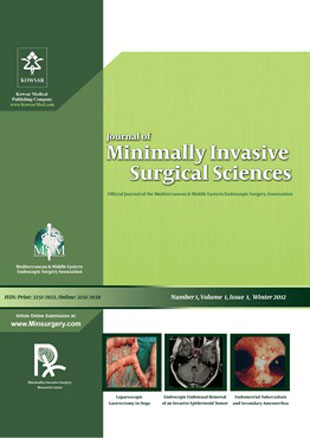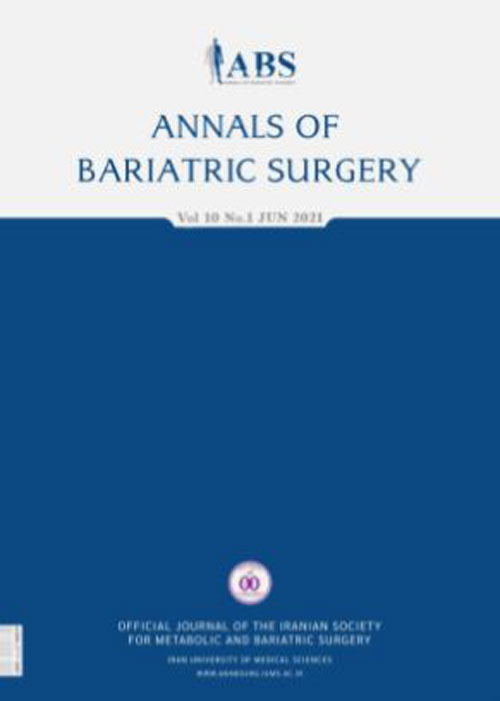فهرست مطالب

Annals of Bariatric Surgery
Volume:1 Issue: 1, Winter 2012
- 48 صفحه،
- تاریخ انتشار: 1390/11/25
- تعداد عناوین: 8
-
-
Page 11BackgroundTotal and partial gastrectomy is commonly used to treat gastric carcinoma or other benign or malignant conditions of the stomach. Laparoscopic-assisted distal gastrectomy is an alternative approach for treating mucosal gastric cancer. Many investigators have assessed the safety, efficacy, and feasibility of this procedure.ObjectivesThe aim of present study is to compare the outcomes obtained using Roux-en-Y and Jejunal Loop Interposition reconstructive techniques after laparoscopic-assisted distal gastrectomy and determine the gross pathologic and histological changes in the anastomotic area and the macroscopic and microscopic pancreatic changes 1 and 3 months after the surgery.Materials And MethodsTwelve adult healthy male mixed-breed dogs were divided randomly into 2 groups of 6 animals each. In group A, left gastroepiploic vessel and its branches, gastroepiploic ligament, and right gastroepiploic vessels were ligated and resected laparoscopically. A loop of jejunum, 20 cm distal to the Treitz ligament, was resected and end-to-side anastomosis was performed between the distal jejunal end and remaining part of the stomach. The proximal jejunal end was end-to-side anastomosed to the rest of the jejunum. In group B, gastrectomy was performed in the same manner. A 20-cm jejunal loop, 20 cm from the Treitz ligament, was resected, and the remaining part of the stomach and jejunum was anastomosed. Jejunojejunostomy was performed between the 2 remaining jejunal parts.ResultsEsophagoscopy showed no en bloc resection of the esophagus or alkaline gastritis. A 2-cm by 2-cm ulcerative mass was observed in the remaining part of the stomach close to gastrojejunal anastomotic site in 1 patient of group A. The animals were killed 1 and 3 month after the surgery. Macroscopic evaluation revealed normal healing of the incisional scars without any inflammation, abscess, adhesion, or other acute or chronic inflammatory reactions. Microscopic evaluation of the pancreatic sections revealed normal appearance of the gland structure, Langerhans islets, and ductal systems without any inflammatory reaction. Decrease in the number of zymogen granules was noted in most of the cases. The junction between the esophagus and stomach was normal in all the cases, and no inflammatory, degenerative, proliferative, hypoplastic, necrotic, hemorrhagic, edemic, and ulcerative changes were noted. There were no pathologic abnormalities in any of the esophagogastric junction sections. In the gastrojejunal anastomotic sites, decreased stomach thickness at the anastomotic site and cystic dilatation of the jejunal crypts was noted.ConclusionsUpper gastrointestinal endoscopy was found to be a useful and feasible technique to detect esophageal gastritis; anatomical structure, obstruction, or stenosis; and other disorders of the upper gastrointestinal tract. In addition, the 2 reconstructive techniques used following gastrectomy yielded similar endoscopic and pathologic findings.
-
Page 17BackgroundPostoperative nausea and vomiting (PONV) are frequent and unpleasant adverse events associated with surgery. The reported incidence of PONV after laparoscopic cholecystectomy (LC) is quite high. Despite the use of different drugs to prevent or relieve PONV, it continues to be undermanaged. Recently, studies have been undertaken to determine if gabapentin can be useful for the prevention of PONV.ObjectivesWe assessed the effect of perioperative gabapentin administration on PONV after LC.Patients andMethodsWe enrolled 92 patients scheduled to undergo LC for a randomized double-blind placebo-controlled study. Patients were divided into 2 groups of 46 patients. Control group patients received a placebo that had the same size and shape as the gabapentin tablets. The intervention group received 2 doses of 600 mg gabapentin: 1 dose 2 h before surgery and 1 dose 6 h after surgery. All Patients were observed for PONV and adverse effects of the drug for 24 h. Metoclopramid (10 mg) was used as the antiemetic and 0.5 mg/kg pethidine to control pain. Total pethidine and metoclopramid consumption were recorded.ResultsThere were no demographic differences between the 2 study groups. Within 24 h of LC, 12 patients who received gabapentin (26.1%) and 30 patients who received a placebo (65.2%) experienced nausea (P < 0.001), while 10 patients in the intervention group (21.7%) and 24 patients in the control group (52.3%) vomited (P = 0.002). Metoclopramid was used to control PONV in 11 intervention patients (23.9%) and 29 control patients (63%; P = 0.001).ConclusionsPerioperative administration of gabapentin significantly decreases the incidence of PONV and the requirement for postoperative antiemetic treatment following LC.
-
Page 21BackgroundFamilial adenomatous polyposis (FAP) is a well-known entity for specialist and it has near 100% chance of malignant changes if does not managed surgically. In order to reduce the disadvantages of laparatomy and diverting ileostomy we present our results of laparoscopic total proctocolectomy without diverting ileostomy.ObjectivesThe aim of this study was to present the results of laparoscopic total proctocolectomy and J pouch ileoanal anastomosis without diverting ileostomy in managing patients with familial adenomatous polyposis (FAP).Patients andMethodsHospital records of 19 patients who were diagnosed with FAP and underwent laparoscopic restorative proctocolectomy without ileostomy were retrospectively evaluated in this study. Early complications and demographic data were considered.ResultsThe mean age of patients was 34 years, with a standard deviation of 4.3 years. The most common presenting symptom was rectal bleeding. Two weeks after the operation, no leakage was detected at the site of anastomosis, but some patients experienced temporary diarrhea and fecal incontinence.ConclusionsLaparoscopic total proctocolectomy and J Pouch ileoanal anastomosis without diverting loop ileostomy seems to be a safe procedure in the management of FAP.
-
Page 24BackgroundObesity has emerged as one of the most serious public health concerns in the 21st century. The consequences of this chronic disorder are serious. Bariatric surgery has been shown to eliminate comorbid conditions associated with obesity. Currently it is considered to be the only successful, long-term therapy for morbidly obese subjects.ObjectivesThe aim of this study was to evaluate the effect of weight reduction following laparoscopic total gastric vertical plication on anthropometric indices, lipid profile and insulin resistance in morbidly obese patients.Patients andMethods15 severely obese patients aged 32.4 ± 10 yr were enrolled in this prospective study. Body mass index (BMI), waist circumference, high-density lipoprotein cholesterol (HDL-c), total cholesterol (TC), low density lipoprotein cholesterol (LDL-c), triglycerides (TG), fasting glucose, fasting insulin and insulin sensitivity were measured before and 6 weeks after laparoscopic total gastric vertical plication (LTGVP). Insulin-sensitivity was estimated using the homeostasis model assessment of insulin-resistance (HOMA-IR).ResultsAnthropometric indices decreased significantly during the 6 week period after LTGVP. TG, LDL-c, fasting insulin, HOMA-IR and QUIKI also decreased but the changes in HDL-c, TC and fasting glucose were not significant. At baseline, we found a direct correlation between weight and TC, weight and fasting glucose, waist to hip ratio and TG and a negative correlation between waist to hip ratios and HDL-c.ConclusionsLTGVP results in significant weight loss among morbidly obese subjects, and following weight reduction, lipid profile and insulin resistance improved.
-
Page 30BackgroundFemale genital tuberculosis is an important cause of secondary amenorrhea and infertility in developing countries where tuberculosis is endemic.ObjectivesWe present three cases in which endometrial tuberculosis was a cause of secondary amenorrhea and infertility.Patients andMethodsIn a retrospective study from January 2007 to June 2010, we conducted 1010 laparoscopies for infertile patients. Among these patients, three had secondary amenorrhea and infertility; therefore, they underwent hysteroscopy and endometrial biopsy.ResultsThe laparoscopic findings showed normal uterus and ovaries in all three patients; although the fallopian tubes were patent in one patient, they blocked in the other two. Hysteroscopy findings revealed that the endometrial layer was atrophied in all three patients, and biopsy results revealed the presence of acid-fast bacilli using Zeihl-Neelsen stain.DiscussionPatients with genital tuberculosis may have no documented history of tuberculosis or may have evidence of tuberculosis lesions elsewhere in the body. Histopathological evidence from biopsies of premenstrual endometrial tissue or demonstration of tubercle bacilli in cultures of menstrual blood or endometrial curetting is necessary to reach a conclusive diagnosis of the disease. When our patients were treated with antituberculosis treatment for 1 year they regained their menstruation but did not achieve pregnancy. Of note, if a patient conceives after genital tuberculosis infection, there is an increased chance of an ectopic pregnancy as a consequence of chronic salpingitis and tubal damage. Gynecologists in developing countries must consider genital tuberculosis as an important cause of tubal blockage and secondary amenorrhea that leads to infertility.
-
Page 34IntroductionEpidermoid tumors comprise 1% of intracranial tumors. Although reported, intraosseous epidermoid tumors are even more rare. Cystic lesions of the petrous apex are uncommon and surgically challenging; the most rare pathology is presumed to be epidermoid.Case PresentationThis is a case of a 61-year-old woman with a large skull-base tumor extending inferiorly from the C1-C2 articulation and superiorly to the tuberculum sella. The lesion replaced the left-sided petrous apex, and the lateral extension of the tumor reached the styloid process. The tumor displayed intradural invasion medial to the internal auditory meatus, producing an intra-axial mass at the level of the upper pons. The patient presented with a 4-month history of headache and total unilateral deafness. Under image guidance, an endoscopic endonasal approach was used to totally resect the tumor. By following the tumor’s dural defect, the intra-axial part of the tumor was safely resected, and the dural defect was successfully repaired.ConclusionsImage-guided endoscopic endonasal surgery is a versatile approach that can safely and easily address a large epidermoid tumor in this challenging region, obviating the need for demanding and sophisticated transcranial surgery.
-
Page 38This article is without abstract.


